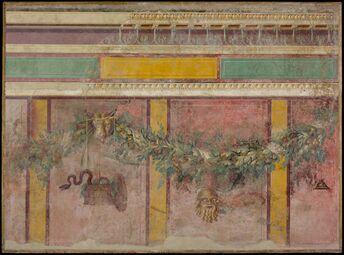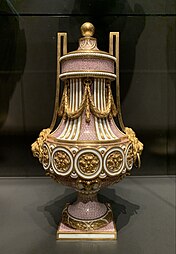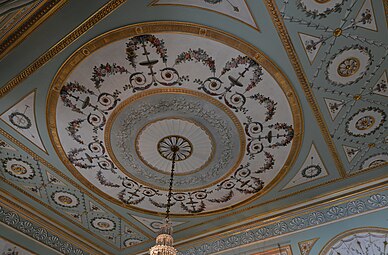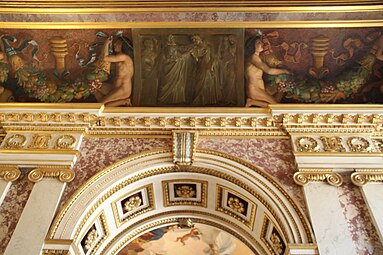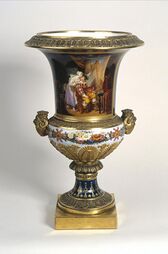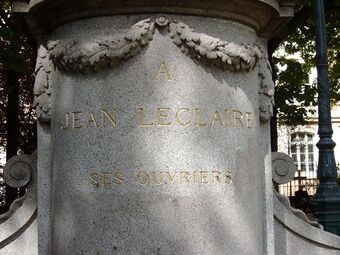Engineering:Festoon

A festoon (from French feston, Italian festone, from a Late Latin festo, originally a festal garland, Latin festum, feast) is a wreath or garland hanging from two points, and in architecture typically a carved ornament depicting conventional arrangement of flowers, foliage or fruit bound together and suspended by ribbons.[2] The motif is sometimes known as a swag when depicting fabric or linen.[3][4]
In modern English the verb forms, especially "festooned with", are often used very loosely or figuratively to mean having any type of fancy decoration or covering.
Origins and design
Its origin is probably due to the representation in stone of the garlands of natural flowers, etc., which were hung up over an entrance doorway on fête days, or suspended around an altar.[2][4]
The design was largely employed both by the Ancient Greeks and Romans and formed the principal decoration of altars, friezes and panels.[4] The ends of the ribbons are sometimes formed into bows or twisted curves; when in addition a group of foliage or flowers is suspended, it is called a drop or margent.[2]
The motif was later used in Neoclassical architecture and decorative arts, especially ceramics and the work of silversmiths. Variations on the exact design are plentiful; for example, the ribbons can be suspended either from a decorated knot, or held in the mouths of lions, or suspended across the tops of bucrania as in the Temple of Vesta at Tivoli.
Gallery
Detail of an Ancient Greek mosaic floor, Pergamon Museum, Berlin, Germany, unknown architect, 2nd century BC
Roman trompe-l'œil wall painting from a villa, with festoons and bucrania, c.50-40 BC, fresco, Metropolitan Museum of Art, New York
Roman festoon, c.70 BC, mosaic, Casa di Nettuno e Anfitrite, Herculaneum Archaeological Park, Ercolano, Italy[5]
Garland of Flowers around an Allegory of Farming, by Jan Brueghel the Elder and Hendrick van Balen the Elder, 1615, oil on panel, Mauritshuis, The Hague, the Netherlands
Baroque festoons on the boiserie of a room from the Hôtel Colbert de Villacerf, now in the Musée Carnavalet, Paris, unknown architect, sculptor and painter, c.1650[7]
Baroque festoon with a mascaron in the Hall of Mirrors of the Palace of Versailles, Versailles, France, designed by Jules Hardouin-Mansart, 1678-1684[8]
Rococo or Louis XVI style festoon ornament, 18th century, gilt bronze, Metropolitan Museum of Art
Louis XVI style Cupid seated on a festoon made of flowers, c.1770-1790, oil on canvas, Metropolitan Museum of Art
Louis XVI style festoons on the Table de Teschen, by Johann Christian Neuber, 1775-1800, gilt bronze, semiprecious stones, porcelain, and wood, Louvre[9]
Neoclassical festoons on a bed, by Thomas Chippendale, 1773, carved and gilt wood, Harewood House, Harewood, West Yorkshire, England
Louis XVI style festoons on a ceiling in the State Dining Room, Inveraray Castle, Scotland, the UK, by Girard and Guinand, 1784[10]
Neoclassical festoon on a vase, by the Sèvres Porcelain Factory, 1814, hard-paste porcelain with platinum background and gilt bronze mounts, Louvre[11]
Neoclassical festoon on the facade of the Palais Garnier, Paris, designed by Charles Garnier, 1860–1875[12]
Festoon on a vase of Anthony van Dyck painting his first painting, by Dalou Aimé-Jules and the Sèvres Porcelain Factory, c.1888, sandstone, Petit Palais
Beaux Arts festoons above the door of Avenue Kléber no. 47bis, Paris, unknown architect, 1908[14]
Neo-Louis XVI style festoons with a medallion above a door in Strada Arthur Verona no. 15, Bucharest, unknown architect, c.1910
Beaux Arts swags of a cartouche on the Nicolae T. Filitti/Nae Filitis House (Calea Dorobanților no. 18), by Ernest Doneaud, c.1910[15]
Rococo Revival festoon on a stained-glass window in the orangery of the Ecaterina Procopie House (Strada Bocșa no. 4), Bucharest, unknown architect or painter, c.1912[17]
Art Deco festoons in the pediment of the Mihai Zisman House (Calea Călărașilor no. 44), Bucharest, by architect Soru, 1920
See also
- Tinsel
- Ornament
- Classical architecture
- Garland bearers
Notes
- ↑ Jones 2014, p. 276.
- ↑ Jump up to: 2.0 2.1 2.2 Chisholm 1911.
- ↑ Fleming, John; Honour, Hugh; Pevsner, Nikolaus (1986). Dictionary of Architecture (3 ed.). Penguin Books Ltd. p. 114. ISBN 0-14-051013-3. https://archive.org/details/penguindictionar00flem_0/page/114.
- ↑ Jump up to: 4.0 4.1 4.2 Sturgis, pp. 22-23
- ↑ Virginia, L. Campbell (2017) (in en). Ancient Room - Pocket Museum. Thames & Hudson. p. 199. ISBN 978-0-500-51959-2.
- ↑ Eastmond, Anthony (2013) (in en). The Glory of Byzantium and early Christendom. Phaidon. p. 66. ISBN 978 0 7148 4810 5.
- ↑ "LAMBRIS DU CABINET DE L’HÔTEL COLBERT DE VILLACERF". https://www.carnavalet.paris.fr/collections/lambris-du-cabinet-de-lhotel-colbert-de-villacerf.
- ↑ Martin, Henry (1927) (in fr). Le Style Louis XIV. Flammarion. p. 31.
- ↑ "Table de Breteuil". https://collections.louvre.fr/ark:/53355/cl010366051.
- ↑ "Ground Floor". https://www.inveraray-castle.com/castle/ground-floor.
- ↑ "PAIRE DE VASES « FUSEAU »". https://www.amisdulouvre.fr/acquisitions/paire-vases-fuseau.
- ↑ Jones 2014, p. 296.
- ↑ "Palais du Commerce". https://www.pop.culture.gouv.fr/notice/merimee/PA00117979.
- ↑ "47 bis avenue Kléber". https://www.bercail.com/paris/75016/avenue-kleber/47-bis.
- ↑ Marinache, Oana (2015) (in ro). Ernest Donaud - visul liniei. Editura Istoria Artei. p. 79. ISBN 978-606-94042-8-7.
- ↑ Cuito, Aurora; Montes, Cristina (2009) (in en, de). Antoni Gaudí – Complete Works. Evergreeb. p. 781. ISBN 978-3-8365-1165-0.
- ↑ "Vila matematicianului Isac Moscuna şi casa Ecaterinei Procopie Dumitrescu, scoase la licitaţie". https://www.economica.net/vila-matematicianului-isac-moscuna-si-casa-ecaterinei-procopie-dumitrescu-scoase-la-licitatie_170129.html.
References
- Hopkins, Owen (2014) (in en). Architectural Styles: A Visual Guide. Laurence King. ISBN 978-178067-163-5.
- (in en) Architecture The Whole Story. Thames & Hudson. 2014. ISBN 978-0-500-29148-1.
Attribution:
Further reading
- Lewis, Philippa; G. Darley (1986). Dictionary of Ornament. New York: Pantheon. ISBN 0-394-50931-5. https://archive.org/details/dictionaryoforna00phil.
- Sturgis, Russell (1901). A Dictionary of Architecture and Building, Volume II. New York: Macmillan.
External links
 |

